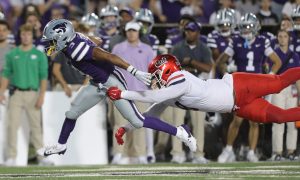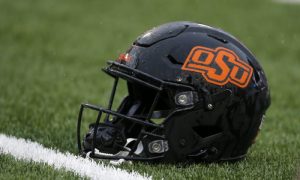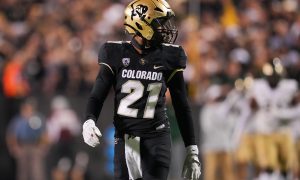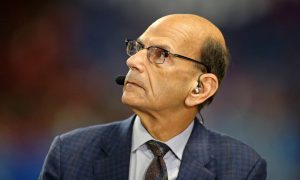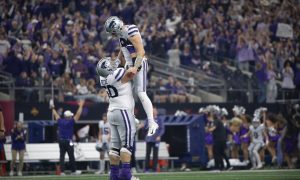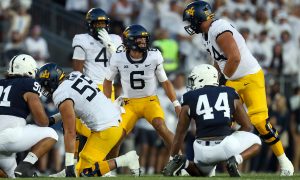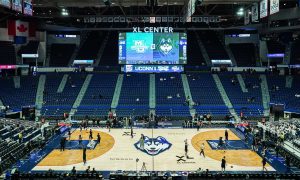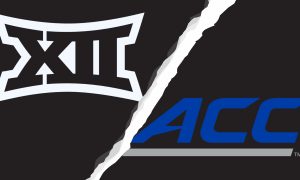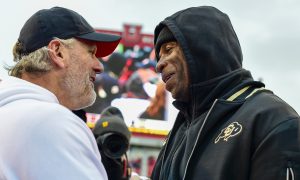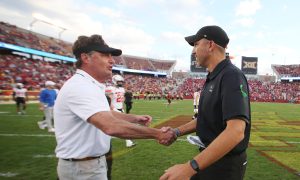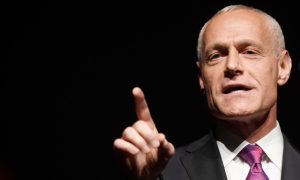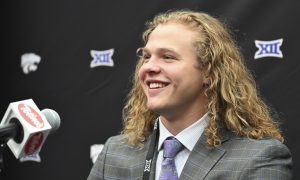Postscripts: Players React to First Ever Big 12 Pro Day
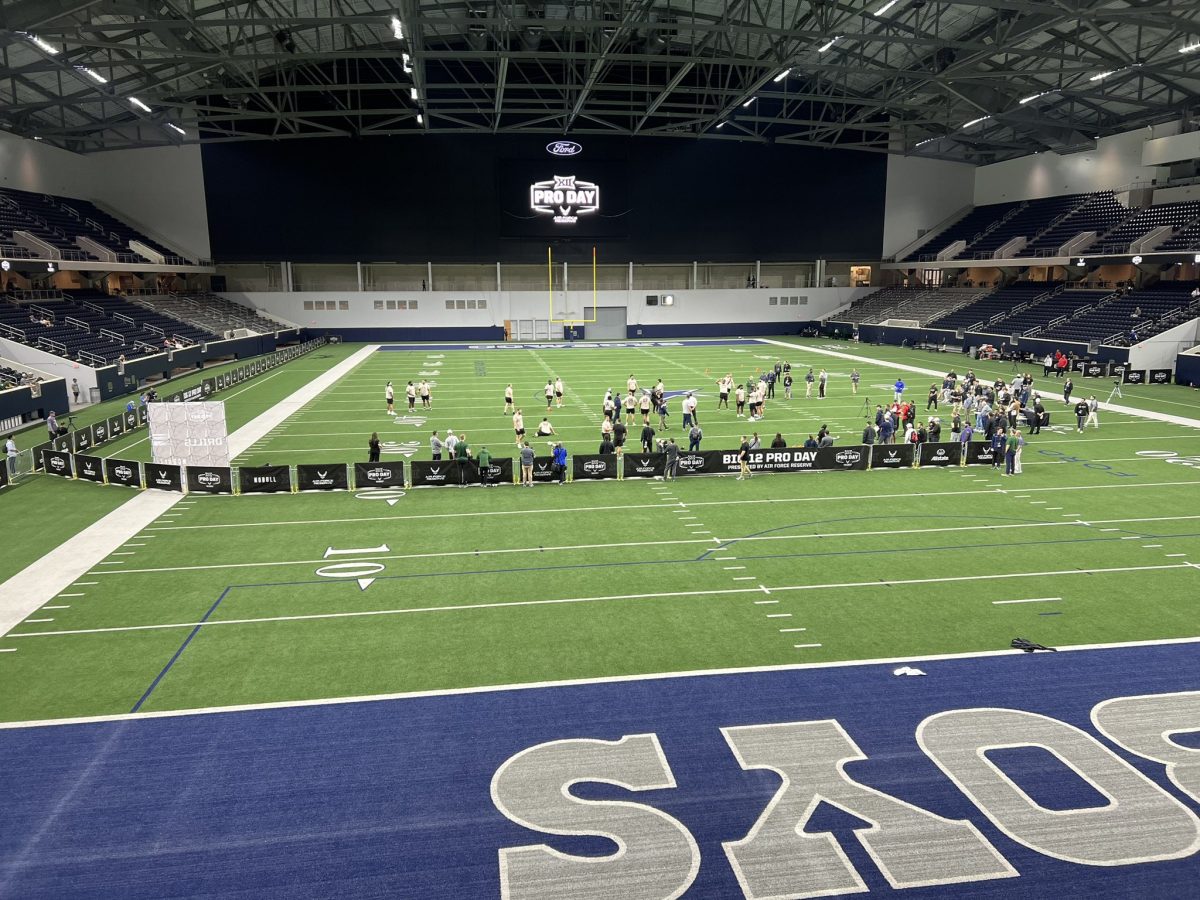
What’s going on in the Big 12 and beyond? I expand and explain every Sunday in Postscripts at Heartland College Sports, your home for independent Big 12 coverage.
This week, it’s all about the Big 12 Pro Day.
The Big 12’s Latest Move
I spent Saturday morning at the first Big 12 Pro Day. It’s the conference’s latest out-of-the-box endeavor and I was curious as to how it would play out.
If you’ve had experience covering pro football like I have, then you wouldn’t have sensed much difference than any other pro day.
I covered the Tampa Bay Buccaneers for four years, so I’ve covered the NFL Scouting Combine, the Senior Bowl and various pro days. This was a combination of a combine and a pro day.
The workouts were what you see on TV when you watch the NFL Combine. I talked with three offensive linemen, two of which went to Indianapolis — TCU’s Andrew Coker and West Virginia’s Zach Frazier. Nothing was different. In fact, Coker said Indianapolis helped prepare him for this. He didn’t have to stress about the workouts because he had been through them once before. Being a fringy draft pick (he’s projected for the late rounds), he wanted every chance he could get to perform for scouts.
Elsewhere, there were differences. The NFL Combine is very regimented. All of the interviews take place away from the stadium. Most don’t even overlap with testing and workouts. Media and fans don’t watch workouts live in the stadium, though one year I covered the Combine I was one of several reporters allowed to “scout” a workout in the RCA Dome and write up a scouting report for the rest of the reporters as an experiment. Let’s just say I kept my day job.
Saturday was more like a pro day in that regard. Media got to watch workouts. So did fans, even though the Big 12 didn’t advertise it. But, if you wanted to, you could have walked into the Star in Frisco, Texas, and watched the Big 12 Pro Day. A Big 12 official told me mostly family of players participating were in attendance. I saw fans from Kansas State, TCU and Texas Tech.
In that way, it was more informal, which matches the pro day workouts I’ve covered.
I’m not sure there is value in the Big 12 turning this into a public event. Watching a combine isn’t exactly scintillating. But it served a purpose for the Big 12 and the more than 200 football players that went through it.
The Big 12 got each of its schools to surrender its traditional pro day and allow the league to put one on for them in Frisco (Texas and Oklahoma, which are leaving the Big 12, held their own traditional on-campus pro days). No conference had ever done this before.
The Big 12, in my opinion, did a couple of smart, strategic things. First, it coordinated coverage with the NFL Network and NFL+. So it got some free media out of it. Second, it aligned the Big 12 Combine with the end of the pro day window so there was less competition for scouting eyeballs.
When the offensive skill players worked out on Thursday, the biggest competition was probably Washington’s pro day. On Saturday the linemen had the day to themselves. It ensured that every NFL team would have scouts there. Those teams probably appreciated being able to have scouts in the same place. Every NFL team has area scouts that work different parts of the country. It allows them to cover more ground. Because of the schedule, teams could have had multiple scouts in Frisco to evaluate and cross-check in person, if they wished.
That’s part of the reason why teams like the NFL Scouting Combine — all the players are in one place. The thing is, only about 40 Big 12 players were invited to Indianapolis. That was reflected in the offensive linemen. Only six of the 21 linemen at Saturday’s pro day went to Indy.
Both Coker and Frazier wanted to work out again for their own reasons. Coker didn’t do his bench press in Indianapolis while Frazier was still not fully recovered from the ankle injury he suffered against Baylor in November. So this gave both a second chance to make an impression.
Just like the Combine and pro days, there were chances for players to meet teams and scouts one-on-one. The third lineman I talked to, Kansas’ Mike Novitsky, spoke with the Ravens and Chargers, two teams he was unable to speak with at an all-star game earlier this offseason. Plus, Novitsky wasn’t invited to the NFL Combine.
Novitsky, like the other players I talked with, liked the idea behind it.
“They have a great set-up and that made things really easy for us,” Novitsky said. “It’s cool because you get to come out here and you get to compete against a whole conference. So that raises the competition level in here and you really see who the best of the best is. I like that aspect.”
It’s a first-of-its-kind idea. The value isn’t in generating revenue for the league. But in this shifting era of college sports, supporting this sort of pipeline to the NFL and cultivating a broader relationship with the league has its upside for Big 12 players, the league and even the NFL.
Relationships are currency in scouting and player evaluation and an entire conference building one with the NFL on this level could be a future asset.
It’s a seed and the Big 12 put some water on it this weekend. Time will tell where it goes. But I don’t think the league is barking up the wrong tree.
You can find Matthew Postins on Twitter @PostinsPostcard.
